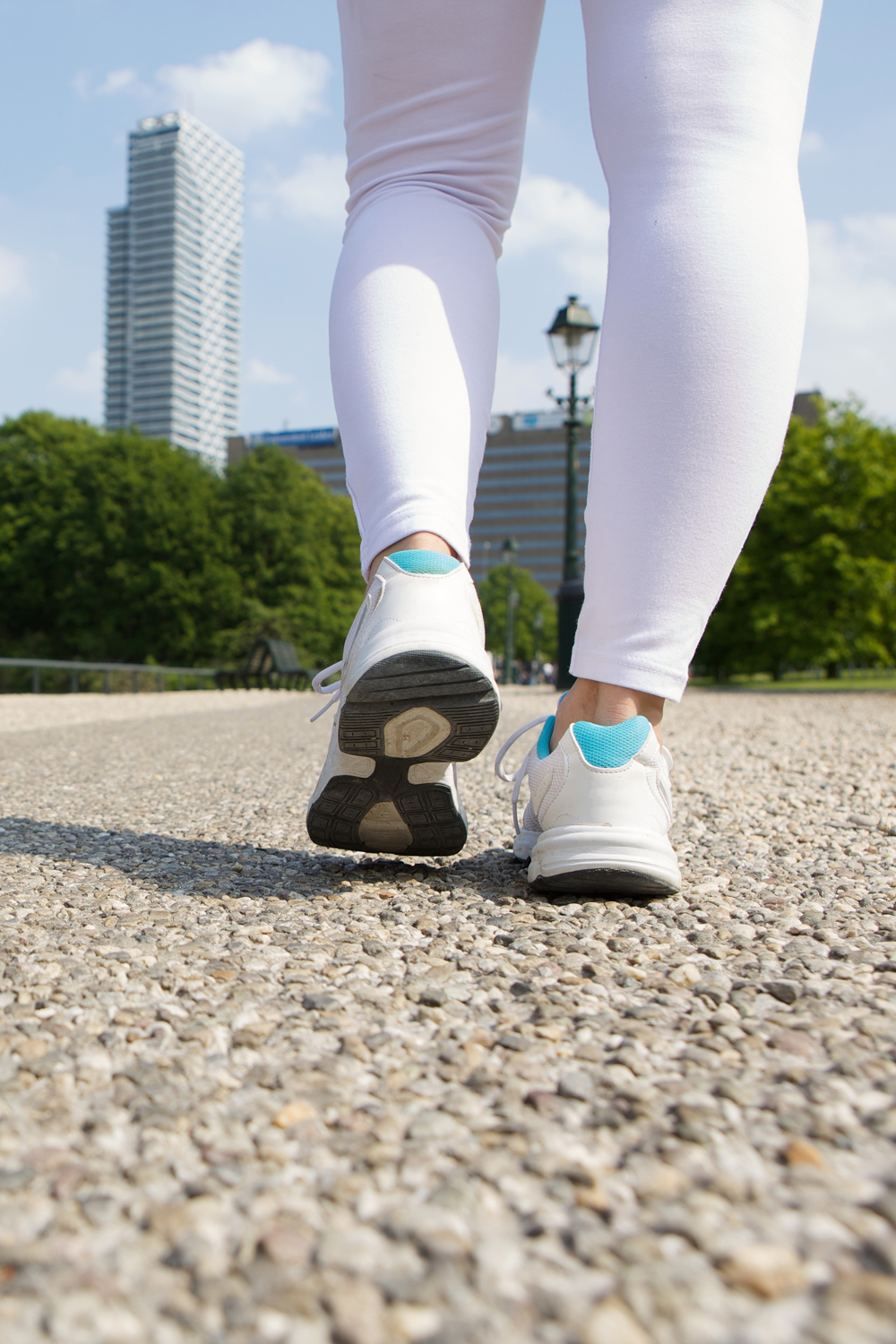Walking A Mile A Day: Weight Loss, Benefits + What To Expect
If you’re struggling with your fitness and weight loss, the walking a mile a day challenge is an excellent starting point. It’s an achievable goal for most people and it doesn’t take too much time out of your day.
Just a one-mile walk every day can be a huge benefit to your overall health. Enjoy better mental health and good cardio – no more struggling to breathe climbing a flight of stairs.
A regular walking routine can be fun and it’s a fantastic way to start the day. Getting up in the early morning for a daily walk puts you in a good mood and you’ll be ready to take on the rest of the day.

How Far Is A Mile?
For metric users, a mile is 5280 feet or 1.609 km. If you’re walking around a standard athletics track, it’s 4 laps plus an extra 9 meters.
In some cities, you can measure distance in terms of blocks. For example, Portland is built on a square grid and 1 mile in any direction is 20 blocks.
How Long Does It Take To Walk A Mile A Day?
If you’re walking a mile at a leisurely stroll it can take up to 30 minutes. That’s a walking speed of 2 miles per hour.
When you’re walking for fitness, the aim is to walk faster at a brisk walking pace where you can still walk and talk but your heart rate is elevated.
According to the Centers For Disease Control And Prevention (CDC), an example of moderate-intensity physical activity is walking briskly at 2.5 to 4 mph. That’s a walking pace of 15 to 24 minutes per mile.
Your average walking speed, how fast you walk, depends on several factors: fitness level, age, sex, terrain, and effort level. Find out more about how long does it take to walk a mile.

How Many Calories Do You Burn Walking A Mile A Day?
The average person burns 80 calories per mile at a typical walking pace but if you’re overweight or obese calories burned can shoot up significantly.
Just like walking speed, there are lots of factors affecting calories burned walking. These are the main ones:
- Body weight: the heavier you are the more calories you burn.
- Walking speed: if you’re walking faster and making more effort, you’ll burn more calories.
- Terrain: walk uphill or on an uneven trail and your effort level increases. The result – more calories burned.
- Age, gender, and fitness level: everyone is unique and these factors will affect your calorie burn rate.
Find out more about how many calories do you burn walking per mile or calculate calories burned with our walking calorie calculator.
Can You Lose Weight By Walking A Mile A Day?
Walking a mile a day will help with weight loss as long as you don’t replace the calories you burn by eating more.
If you combine walking a mile a day with improving your diet, a daily mile is a great tool for weight loss:
Walking burns calories
A mile a day may only burn 80 calories but that’s 560 calories a week. It all adds up and contributes to the calorie deficit you need to lose weight.
Walking boosts your metabolism
Increased muscle mass from walking and power walking at a fast pace can help to boost your metabolism. This means you’ll burn more calories at rest.
Walking helps to reduce stress
High levels of cortisol, the stress hormone, can lead to weight gain. Walking a mile a day is an effective way to manage your stress and lower cortisol levels.
You’ll sleep better
There are no guarantees but exercise helps most people fall asleep faster and sleep better at night. It’s much easier to keep to a healthy diet when you’re getting enough sleep.
Your weight loss will be from body fat
Your diet will always have the biggest impact on your weight but unless you exercise when cutting calories, it’s unlikely you’ll get the body you want.
When you diet but don’t exercise, your body will burn any available fuel for energy. That includes muscle mass as well as body fat.
Walking a mile a day builds muscle, so your exercise routine makes it far less likely that your weight loss will be from muscle loss. Instead of skinny fat, you’ll be lean and strong.
Restrictive diets result in rebound weight gain when the diet stops. Slow and steady weight loss with a small calorie deficit from healthy eating and exercise is the route to permanent weight loss. Lose weight and keep it off.
Find out more about walking for weight loss.

Benefits Of Walking A Mile A Day
Walking isn’t just about losing weight, there are many health benefits from walking a daily mile.
Better mental health
Walking in the fresh air is good for your mental health. Research confirms that walking can clear your mind and help reduce stress, anxiety, and depression.
Reduced risk of heart disease
Walking is good for your heart and protects against cardiovascular disease. Brisk walking increases blood flow and helps to reduce high blood pressure.
Reduced risk of Type 2 diabetes
Physical activity, such as walking a mile a day, helps to reduce the risk of developing diabetes. It can also help manage your condition if you already have diabetes.
Improved posture and balance
Walking is an easy way to improve your overall fitness level. It strengthens your muscles, ligaments, and tendons in addition to improving posture and balance.
Better bone health
Weight-bearing exercise, such as a daily mile of walking, puts a gentle strain on your bones and makes them stronger. This can help reduce the risk of developing osteoporosis.
Walking can also help to reduce joint pain. Joints are meant to move, so regular activity can help to relieve arthritis. Just don’t overdo it. A daily mile is ideal.
Improved immune system
Walking is a way to boost your immune system. Studies have found that moderate to vigorous intensity exercise for less than 60 minutes enhances immune defense activity. Expect greater protection against colds and flu.
These are just some of the health benefits of walking. Find out more about the benefits of walking 30 minutes a day.

Is Walking A Mile A Day Enough Exercise?
For health and fitness, walking a mile a day is a big step towards hitting the recommended CDC physical activity levels of 150 minutes per week of moderate-intensity activity or 75 minutes of vigorous-intensity exercise.
A brisk walk counts as moderate activity. Intense exercise such as running or HIIT counts as vigorous activity. CDC also recommends at least 2 muscle-strengthening activities a week working all the major muscle groups. This could be anything from strength training to climbing or yoga.
Walking one mile a day at a brisk pace takes about 20 minutes. This works out at 140 minutes of moderate exercise a week – just short of the recommended level.
To hit the recommended levels, try and walk a little further one day a week or try walking 2 miles a day. Combine with a short daily yoga session or try these bodyweight exercises 2-3 times a week.
These are minimum exercise recommendations for good overall health. What counts as enough exercise will depend on your fitness goals.
If you want to be fitter and stronger, only one mile a day won’t be enough – but it’s a good starting point. Walking a mile daily is something almost everybody is capable of. As you get fitter you can progress to walking 3 miles a day, walking 4 miles a day, or even walking 5 miles a day.
How To Start Walking
Most people can jump straight into walking a mile a day without any buildup. If you suffer from any health issues, check in with your doctor before you start.
If you’re starting from a very low fitness level, try walking a mile every other day for the first week. This will give your body a chance to recover between walks.
Our Walking Program for Beginners Guide tells you how to prepare for your first walk and how to walk properly with good form.

Tips For Walking A Mile A Day
These tips will help you walk a mile daily:
#1 Walk Regularly
It’s important to walk regularly – walk a mile every day instead of walking further on day 1 and then taking the rest of the week off.
Consistency is the key to improving your fitness. Walking a mile every day will help you form a healthy habit and keep to it for the long term.
#2 Invest In The Right Gear
Comfortable walking shoes or trainers are essential. You’ll also need non-restrictive clothing and most women will benefit from a good sports bra.
If it’s hot or you’re worried about getting thirsty, take a handheld water bottle with you.
#3 Set Goals
Set yourself fitness goals – “I’m going to walk a mile every day this month” will give you something to aim for and help you stay motivated. Keep a record of your walks to show progress.
#4 Schedule Your Walks
Pick a time of day for your walks and try to keep to it. It can be early morning, during your lunch break, or after work. Keeping to a regular time will help you to be consistent.
#5 Walk In Nature
Nature has a calming effect on the mind – so try and walk in nature as much as possible. This could be your local park or woodland or even just going for a walk near some trees.
#6 Use A Step Counter
Track your steps with a fitness tracker or wearable device to help you stay motivated and measure your progress. You’ll get a buzz every time you hit your step target.
Related post: How Many Steps In A Mile Walking or Running?
#7 Walk With A Buddy
It’s so much easier to exercise if you find a walking partner. Persuade a friend or family member to join you and you can enjoy the fresh air together.
#8 Walk When You Don’t Feel Like Walking
You won’t always feel like going for a walk. Some days it’s going to be difficult to lace up your trainers and leave the house.
Hang in there! These are the days when it’s really important to start your walk.
You can tell yourself you’ll just walk for 5 minutes. By the end of 5 minutes you’ll probably feel able to walk a little further and before you know it you’ll have completed your mile. Job done.
Take the Love Life Be Fit 30 Day Walking Challenge For Beginners
Our 30-day walking challenge for beginners will ease you into exercising. You’ll start by walking 1 to 2 miles a day – that’s 20 to 40 minutes of exercise. Every Sunday your walk will be a little longer until at the end of the challenge you’ll be capable of walking 5 miles without stopping.
Thoughts From Love Life Be Fit
Walking a mile a day is an investment in your health and a big first step on the road to fitness. Instead of feeling overwhelmed about your health, try and concentrate on making small positive changes one at a time.
Start by walking a mile every day. when you’re used to your new routine, make one or two small improvements to your diet. Nothing too drastic – aim for sustainable changes. Build good habits on top of other good habits – one at a time.







